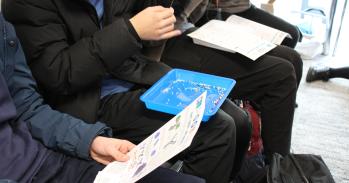
The question of 'public engagement' for universities is rising up the political agenda. Universities are increasingly being asked to demonstrate their work in knowledge transfer with community groups and the public, as well as with business.
The question of 'public engagement' for universities is rising up the political agenda. Universities are increasingly being asked to demonstrate their work in knowledge transfer with community groups and the public, as well as with business.
Now that the University’s public audience exists on a local, national and global scale, can we move beyond the ‘show and tell’ and ‘parallel play’ model of community engagement?
Professor David Watson
The question of ‘public engagement’ for universities is rising up the political agenda. Universities are increasingly being asked to demonstrate their work in knowledge transfer with community groups and the public, as well as with business.
Science and technology – public engagement
‘Blind faith in the men in white coats has gone and isn’t coming back.’ This statement by the polling organisation, MORI describes the damage to public trust in science following controversies in the media concerning BSE, GM foods and the MMR vaccine among others.
In response to this mistrust, a plethora of ‘public engagement with science’ initiatives have recently emerged in the UK. At its most ambitious, this activity aims at the open exchange and sharing of knowledge, ideas, values and beliefs between scientists, the public(s), stakeholders and decision-makers.
‘Sciencewise’ is a Government programme which illustrates a growing commitment from policymakers and scientists to engage the public ‘upstream’ with consultations on new technologies. In addition to seeking advice from scientists and social scientists (as provided by the Cambridge University Government Policy Programme, for example), there is a national programme of public dialogue on issues of scientific concern. The University of Cambridge actively supports this as demonstrated by its sponsorship of the ‘Nano Jury UK’ last year. A five-week long citizens’ jury on nanotechnologies gave the public the opportunity to become part of the debate as to how this emerging and potentially revolutionary technology should develop.
The University also holds a number of public talks, discussions and debates each year, publicised through events such as the Cambridge Science Festival and the Darwin Lecture series.
Future scientists
The downward trend in the number of school pupils studying science and embarking on scientific degrees and careers is another incentive for scientists to engage new audiences. In the last 10 years, 21 physics departments have been reportedly closed at British universities.
According to a Royal Society survey (2006), pressures on scientists to spend time on research and teaching act as a barrier to getting more involved with public engagement of science. This is not true for the University of Cambridge. Over 1000 scientific staff and students are involved in 50 or more science educational outreach projects at the University.
The ‘Millennium Maths Project’ works with hundreds of schools throughout the UK – its web resources received 6.4 million visits last year. The Department of Physics has a year-round programme of educational outreach activity, including its popular Physics at Work days each September which bring in 2500 school pupils to meet commercial and academic scientists. The Cambridge Science Festival takes place every March, during National Science and Engineering Week, attracting over 25,000 visitors of all ages to 100 free events throughout the University. These initiatives cross-over with the University’s widening participation and aspiration-raising work, and involve pupils of all ages from primary school upwards.
The University’s Humanitarian Centre is a new initiative bringing together research and outreach work for community benefit worldwide. Fifteen relief and development organisations including ‘Engineers without Borders’ and ‘Architecture sans Frontières’ are collaborating on sharing resources and placing students in positions to offer humanitarian assistance.
Arts, humanities and social science
The arts, humanities and social sciences often by their very nature engage with the wider community and they play a complementary role to the sciences in engaging with audiences external to the University. In fact, much of the understanding of good practice in public engagement with science has come from social studies of this field. Dr Robert Doubleday is a social scientist who until recently was based at the Centre for Nanoscience. Now at the Department of Geography, he works with scientists to investigate the social and ethical dimensions of their research. He was also active in the ‘Nano Jury’ project.
Numerous researchers in arts, humanities and social sciences interact with external audiences regularly as part of their studies, and the results often directly impact on the wider world. The University’s Centre for Family Research is one such example, with its close connections with the health service, the education system, child and adult psychiatry, clinical genetics, adoption and family lawyers.
The University museums are active in engaging the public with the impressive collections held by the University for the benefit of all. The University is a significant investor in 10 museums and collections for the local community. The Fitzwilliam Museum receives 300,000 visits each year and their initiatives include taking art to patients at Addenbrooke’s Hospital and planning virtual visits to the Museum for inmates at nine English prisons. Notable other cultural amenities for the public provided by the University include Kettle’s Yard, the ADC Theatre and concerts at West Road Concert Hall. At the University Library, half of its readers’ tickets are held by people who are not University members but are eligible to use the Library for academic research.
Modern languages were dropped as a compulsory school subject in 2002, leading to widespread concern that students will not be prepared with language-learning skills for the future. In response, the University Language Centre has worked with six schools in Cambridgeshire to offer teaching in a language that their school cannot offer otherwise. This scheme is rolling out to north-east England and other locations.
The Cambridge Schools Classics Project was established in 1966 and has played a vital role in keeping Classics in UK school education by creating innovative teaching and learning materials.
And finally, not to be outdone by the popularity of the Cambridge Science Festival, a Festival of Arts, Humanities and Social Sciences – or as it might be configured, a ‘Festival of Ideas’ – is planned at the University in October 2008.
The future
Now that the University’s public audience exists on a local, national and global scale, can we move beyond the ‘show and tell’ and ‘parallel play’ model of community engagement? Can we continue to enter into ‘genuine collaboration with community partners in fields which may be long-term, uncertain and genuinely risky’, as David Watson, Professor of Higher Education Management at the Institute of Education urges universities to do?
Pro-Vice-Chancellor Dr Kate Pretty certainly thinks so: ‘The University’s public engagement work stretches back over 150 years and more, looking back to the foundation of our Continuing Education programme and the whole area of work, including examinations worldwide, are now run by Cambridge Assessment. These important parts of the University’s work are still going strong today and there is now a huge range of public engagement initiatives accessible via the Cambridge for All portal.’
For more information, please contact Nicola Buckley, Festivals and Outreach Co-ordinator (njb1010@cam.ac.uk) or go towww.cam.ac.uk/cambforall
This work is licensed under a Creative Commons Licence. If you use this content on your site please link back to this page.





